Further product information
When to use Mepilex Border Heel
Treatment
Mepilex® Border Heel is specifically designed to fit the heel. The five-layer absorbent foam structure effectively manages exudate and the wound environment. So you can use it in the treatment of exuding wounds such as pressure ulcers, diabetic foot ulcers, heel ulcers, traumatic wounds, and other secondary healing wounds.
Pressure ulcer prevention
Mepilex Border Heel has been proven to prevent pressure ulcers
Note: using dressings as a prophylactic therapy does not replace the need a comprehensive pressure ulcer prevention protocol.
How to use Mepilex Border Heel
Watch how to easily apply Mepilex Border Heel to help you achieve the best result for your patient.
How Mepilex Border helps in pressure ulcer prevention
Discover how Mepilex Border Heel helps ulcer prevention. It is easier than you may think.
Watch Prof. Gefen explain the modern science on aetiology of pressure ulcers
Related products
'References'
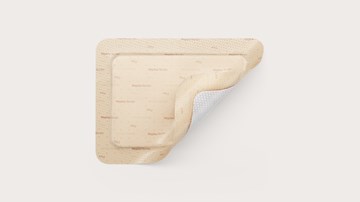
 Newly launched Mepilex Border Heel with enhanced user features
Newly launched Mepilex Border Heel with enhanced user features





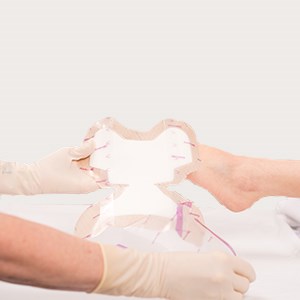 After the skin/wound is prepared, dry the area thoroughly. Then remove the central backing and slide the dressing under the heel to the desired location.
After the skin/wound is prepared, dry the area thoroughly. Then remove the central backing and slide the dressing under the heel to the desired location.
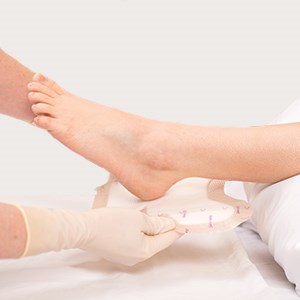 Apply the adherent part of the dressing marked ‘A’ (see illustration above) to the posterior heel/ Achilles tendon areas, positioning the narrowest part of the dressing at the base of the heel. Do not stretch.
Apply the adherent part of the dressing marked ‘A’ (see illustration above) to the posterior heel/ Achilles tendon areas, positioning the narrowest part of the dressing at the base of the heel. Do not stretch.
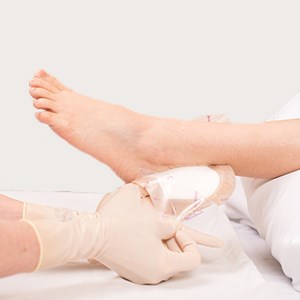 Remove the backing from one of the area ‘A’ flaps (ankle flaps). Apply and smooth. Repeat with the other side. Do not stretch.
Remove the backing from one of the area ‘A’ flaps (ankle flaps). Apply and smooth. Repeat with the other side. Do not stretch.
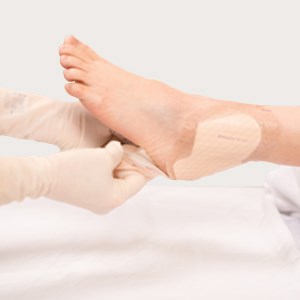 Gently apply the adherent part of the dressing marked ‘B’ (see illustration above) under the plantar surface of the foot. Do not stretch.
Gently apply the adherent part of the dressing marked ‘B’ (see illustration above) under the plantar surface of the foot. Do not stretch.
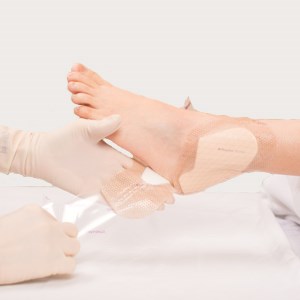 Remove the backing from one of the area ‘B’ flaps (flaps with tabs). Apply and smooth border. Repeat with the other side. Do not stretch.
Remove the backing from one of the area ‘B’ flaps (flaps with tabs). Apply and smooth border. Repeat with the other side. Do not stretch.
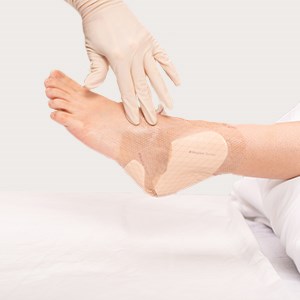 Press and smooth the dressing to ensure the entire dressing is in contact with the skin.
Press and smooth the dressing to ensure the entire dressing is in contact with the skin.
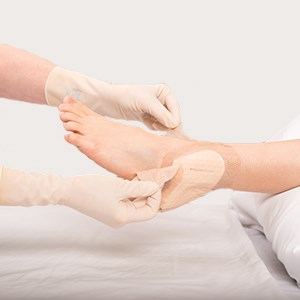 Gently pull handling tabs to release dressing from skin.
Gently pull handling tabs to release dressing from skin.
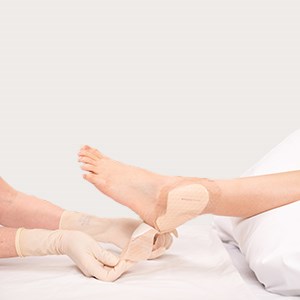 Continue to release the dressing from the skin using the handling tabs until the skin is exposed for skin check.
Continue to release the dressing from the skin using the handling tabs until the skin is exposed for skin check.
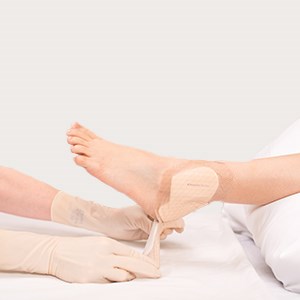 While maintaining the dressing position at the proximal edge of ‘A’ (see picture), perform assessment of the skin.
While maintaining the dressing position at the proximal edge of ‘A’ (see picture), perform assessment of the skin.
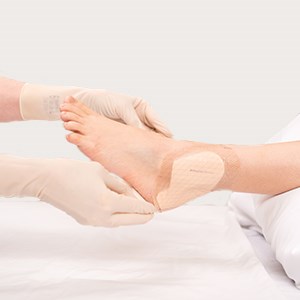 Re-apply the foam and border of the dressing. Make sure the flaps with the tabs are placed over the ankle flaps.
Re-apply the foam and border of the dressing. Make sure the flaps with the tabs are placed over the ankle flaps.
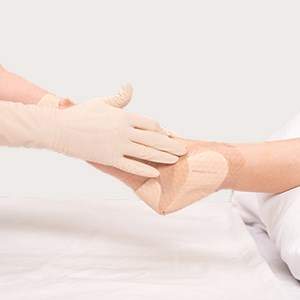 Confirm dressing is replaced to its original position, making sure the border is intact and flat.
Confirm dressing is replaced to its original position, making sure the border is intact and flat.
 Press and smooth the dressing to ensure the entire dressing is in contact with the skin. Re-apply non-skid sock if using, especially for ambulatory patients.
Press and smooth the dressing to ensure the entire dressing is in contact with the skin. Re-apply non-skid sock if using, especially for ambulatory patients.









